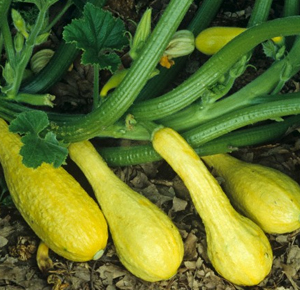You are in : GARDENING » VEGETABLES » Pumpkin
Pumpkin
| Scientific Name : Cucurbita maxima. |
| Family : Cucurbitaceae |
| Colour : Light yellow-orange to bright orange |
| Best Season : Throughout the year |
| Nutritional Value : Calories:32, Carotenes:3,255, Potassium : 280mg,
Vitamin C: 15mg, Vitamin Esp; 1,8mg per 100g serving. |
| RECIPES |
Native to Central America, Pumpkins
are a nutritious vegetable vine plant which date back many centuries. The
name pumpkin originated from the Greek word 'pepon' for large melon. The French
turned 'pepon' into 'pompon' and the English changed that into 'pumpion'. The
present name pumpkin was chosen by American colonists. It was one of the major
ingredients of the staple diet of native Americans and colonists. There are about
26 species of cucurbita.
The spherical shaped fruits range in
weight from less than 0.5kg to more than 50kg. Its ability to grow to such a large
size makes it the largest fruit in the plant kingdom. The pumpkin plant which
grow up to 25 feet long produces both male and female bright yellow coloured flowers
with five petals. The female flower has a little pumpkin at the bottom.
The leaves are lobed with 3 or 5 lobes. Pumpkins were used to treat bladder problems
and as a pain killer. Its seeds are an excellent source of fat and protein.
Propagation and Planting
Propagation
is through seeds. The best time to plant pumpkins is late May or early June. Seeds
can be sown directly in the soil. Pumpkins grow best in sunny areas, where
they could receive at least six hours of direct sunlight every day. Pumpkin plants
love lots of growing space. Although not necessary, you can soak the pumpkin seeds
in water the night before planting. This helps to soften the outer shell and make
sprouting easier and faster. Since Pumpkins are a warm season crop they need fertile,
aerated soil with a pH between 5.5 and 6.5. It is best to add nitrogen
while preparing soil for planting.The planting hole should be about 2 feet apart
and two seeds can be placed in each hole at a depth of 1” with the pointed side
of the seed facing down. The seeds start germinating after 7 days.
Pumpkins
need to be watered regularly throughout the growing season. Pumpkins need lots
of indirect water, and the soil of the mound should be kept well moist but not
wet, at all times. Remember not to water the pumpkin foliage. As it gets
warmer you may need to water more than once a day. The best indicator is the plants
leaves. If they are green and look healthy, they're probably getting enough water.
If the leaves look wilted, they need more water.
Varieties
Queensland
Blue and Jarrahdale are two good keeping pumpkins. They have a blue-grey skin
and rich yellow or orange flesh. The Butternut pumpkin is quite popular. The fruit
can vary from pear-shaped to long or round and the flesh is orange. Golden Nugget
grows on a bush approximately 60 cm high and 60 cm across. The skin is bright
orange and the flesh is deep yellow. Other varieties of pumpkin are Baby Blue,
Jap, Hartley's Ironbark, Hybrid Grey Crown, Buttercup, New Turks Turban and Papaw.
Problems and Care
Pumpkins are
susceptible to many diseases and insect pests. The main pests of pumpkins are
aphids, pumpkin beetles, Cucumber beetles, squash vine borers and squash bugs
and the leaf-eating ladybird. Dusting or spraying regularly before an infestation
especially during egg laying and hatching, crop rotation etc is recommended.
Powdery
mildew is a common disease of pumpkins. Downy mildew disease can also affect pumpkins.
At times, pumpkins can become affected by watermelon mosaic virus. The symptoms
are prominent mosaic patterns of light and dark green on the leaves and fruits.
Plants infected at an early stage become stunted and their yield is decreased.
Infected fruit show irregular, raised blisters. The disease is spread by aphids.
Unfortunately, no varieties are resistant to this disease. Removing and burning
all infected leaves and crops will help to check the spread of the virus.
Questions of Vegetables
Questions & Answers |
|
| 1. |
Posted on :
20.8.2013 By : Shibu Daniel , Jaleeb Al Shoukh
|
View Answer (2)
|
Post Answer
|
|
| |
WHAT TYPE OF CLIMATE IS SUITABLE FOR CLOVES TO GROW? |
|
|
| A1: |
how long will it take to grow plant |
| |
Posted By :Sumaiya , vijayanagar | On 8.3.2017 |
|
|
|
|
| 2. |
Posted on :
28.8.2012 By : Srinivas , Hyderabad
|
View Answer (2)
|
Post Answer
|
|
| |
Ever time i grow ladies finger plants, they are stunted, they dont grow more than 1 feet height, they just flower poorly and dry. Does it specifgy any nutrional deficiency?? |
|
|
| A1: |
Use indian cow dung and urine as fertilizer. You should get good result. Also use non-hybrid seeds. |
| |
Posted By :Kiran , Pune | On 23.2.2015 |
|
| A2: |
Request you to kindly purchase good quality of seeds, pls verify your soil is ok or not, if not pls mix soil & compose approx 70/30 share and put ur seeds 3days in sunlight before panting. |
| |
Posted By :Alok Kayal , Secunderabad | On 2.1.2013 |
|
|
|
|
| 3. |
Posted on :
17.1.2012 By : Gangadhar , Secunderabad
|
View Answer (0)
|
Post Answer
|
|
| |
Am planning to cultivate pumpkin and thinking to sow seeds in january month end is there any risk and what will be the average yeild per acre at maturity. |
|
|
|
|
| » more... |


